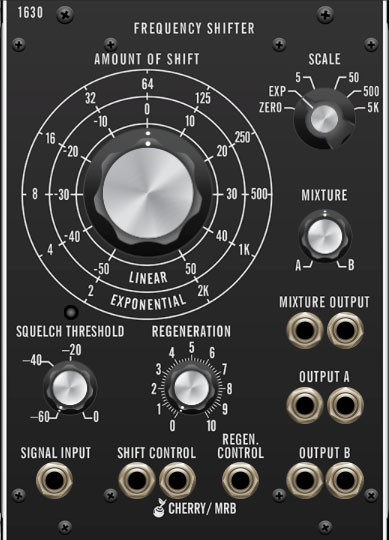The VM1630 is a super-accurate recreation of the vintage Bode 1630 Frequency Shifter. A frequency shifter is an audio modifier that "shifts" the entire frequency spectrum of the signal by a given amount. The VM1630 can shift the spectrum up or down by up to 5000 Hz, and the "downshifted" and "upshifted" signals are simultaneously available. The shift amount and regeneration controls are fully voltage controllable.
What Is A Frequency Shifter?
It's important to understand how a frequency shifter differs from a modern digital pitch shifter (aka, a "harmonizer"). A pitch shifter maintains harmonic relationships between tones and harmonics of the input signal (or at least, tries to). If you speak or sing into a pitch shifter, this means the voice sounds like a larger or smaller person, because the harmonic relationships are maintained. Conversely, these harmonic relationships are not maintained with frequency shifter, and as a result, processed audio starts to sound unnatural beyond very small amounts of shift. Small amounts of shift are useful for phase-y types of sounds (particularly when the Regeneration knob is up). Large amounts generally create harmonically rich and clangorous metallic timbres.
In layman-est of layman's terms, even if you don't 100% understand what's going on under the hood, the frequency shifter can make a whole lot of incredible sounds, and it's very easy to use.
Inputs, Outputs, and Controls
Signal Input- Patch inputs signals here.
Amount Of Shift / Scale selector- These determine the amount of shift. The Scale selector switch determines the range, and the Amount Of Shift knob sets the specific shift amount (and looks real cool). The Scale positions are as follows:
Zero- No shift, aka bypass mode. All three output pairs pass the input signal unaltered.
Exponential- The Amount Of Shift knob scale is exponential, with frequency shift amounts represented in the outer concentric circle. In exponential mode, the shift range is 2 Hz to 2 kHz, from full counterclockwise to full clockwise.
5/50/500/5k- The Amount Of Shift knob scale is linear, with frequency shift amounts represented in the inner concentric circle. Shift amount starts at zero (center position) and goes down or up when the Amount Of Shift knob is turned counterclockwise or clockwise, respectively. The maximum setting in either direction is determined by the current Scale range.
Shift Control jacks- These CV inputs allow voltage control of Amount Of Shift.
Squelch and LED- Allows fine-tuning of input level to prevent bleedthrough in the processed signal. This is typically more of an issue with hardware frequency shifter, but we've included it for accuracy. If it's set too high, it will mute signal entirely. The LED illuminates to indicate signal is passing.
Regeneration- This is a feedback control that sends the output back to the input at an amount determined by the knob setting. It really opens up a lot of sonic possibilities, and is particular useful for phaser-type sounds.
Regen. Control- CV input for voltage control of the Regeneration knob.
Mixture- Sets the mix level between downshifted (A) and upshifted (B) signal at the Mixture Output jacks. It has no effect on the Output A and Output B jacks.
Mixture Output jacks- Audio output of the downshifted (A) and upshifted (B) signals. Both jacks carry the same signal.
Output A jacks- Audio output of the downshifted signal. Both jacks carry the same signal.
Output B jacks- Audio output of the upshifted signal. Both jacks carry the same signal.
